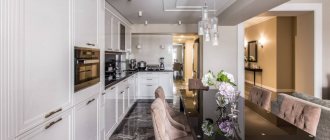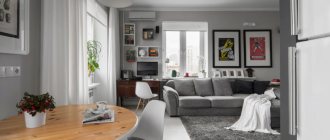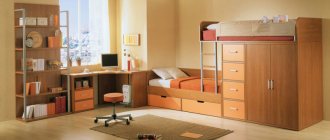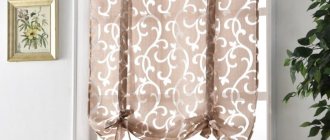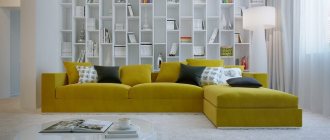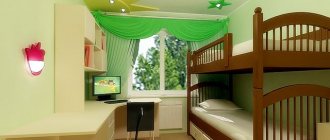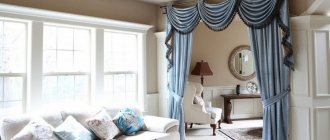Window decoration
Contrasting colors in the window opening visually reduce the area of the room. Therefore, the windows in the interior of such a room should be decorated with curtains identical to the tone of the walls.
Curtains do not have to completely match the tone of the walls
The color scheme in favor of pastel shades fits well into the interior and optically expands the space.
Light curtains increase visual space well
Horizontal or diagonal stripes can also visually enlarge a room.
Choose curtains without strong contrast between the stripes
The curtain fabric should not be too dense or heavy.
Light, airy fabrics do not visually make the room smaller
For small rooms, it is better to choose curtains that cover the entire height of the wall - from ceiling to floor.
Such elongated vertical lines will visually expand the space in height.
When decorating, do not get carried away with lambrequins and other horizontal details. In a small room, curtains should be as simple as possible.
If you decide to add lambrequins, then choose the most transparent and airy fabrics
You can combine roll mechanisms with light tulle.
In some cases, you can combine curtains
What wallpaper makes a room look bigger?
- Use cool colors: purple, blue, green, blue. Prefer pastel colors to bright shades.
- Smooth plain or finely patterned wallpaper will visually enlarge the room.
- Large patterns and textured finishes on individual walls will help visually change the geometry of the room.
- To visually lengthen a small room, decorate the opposite walls in lighter colors than the adjacent ones.
Light wallpaper will make the room more spacious, and a vertical strip will visually raise a low ceiling.
If you are looking for a solution to make a long narrow room visually wider, use the game of contrasts. Finish the far walls with colors darker or brighter than the nearby ones.
Remember : a vertical stripe adds height, and a horizontal stripe adds width.
Organization of light sources
Natural lighting is a priority. Window sills should not be cluttered with flowerpots and other items. Even the smallest room, filled with sunlight, looks cozy and airy.
The more light, the more spacious the room looks
Artificial lighting can be varied. Spot lighting for interior items, a table lamp, a wall sconce - all these are good solutions for a small room. Directing the light upward will help to visually raise the ceiling.
An excellent option is one “flood” lamp and several spotlights.
If you install ceiling lights at equal distances around the entire perimeter, you can not only provide uniform lighting, but also visually move the walls apart. The light and glossy ceiling surface reflects light well and gives a feeling of space.
Mirror surfaces are our main helpers in increasing space
How to increase space? Designer tips
Space is the most convincing and expensive way to demonstrate comfort and, as a result, coziness.
It is for this reason that we strive to change our one-room apartment to a three-room one, a house with one bathroom to a two-story cottage with two, and an apartment with a low ceiling to a similar one with a high one.
But, unfortunately, our reality is that most of us do not live in spacious houses, and this most often means that our housing is small and, moreover, is usually poorly lit. But, despite this, the desire to feel free space around us, and with it lightness, not only does not leave us, but also intensifies during renovations.
How can you visually increase space? Designer tips
The easiest way to make a room larger is to physically move the walls apart. But, if this cannot be done because of the neighbor’s apartment, you will have to work with what you have. And then THEY come to your aid - designers, and with them the basic principles that can visually expand your room. In this article we will look at some of them.
Clutter makes a room look smaller
One of the main and simple rules of design is to get rid of clutter. A large number of items makes your room smaller, as they visually divide the space of your room as much as smaller parts. Which proves the paradoxical statement that “less is sometimes more.”
Everything is in its place. No mess
More light - more space
Nothing makes a room feel more spacious than maximum light.
Try removing all the furniture from your room and painting it completely white... You'll get the instant effect of an expanding space. And all because the eye now has nothing to cling to and, as a result, the boundaries between the floor, wall and ceiling disappear, which means that your room now has no boundaries.
You can achieve this effect without resorting to extremes using the simplest actions: using white surfaces near the window, predominant hard, glossy coatings, avoiding carpeting, etc.
More light - more space
Saturated colors compress space
In real life, few of us can decide to paint the walls white. But, wanting to visually increase the space of our room, we should strive for this color. Use desaturated colors whenever possible, without using any patterns or dividing the wall plane into separate sections. Then the boundaries of your walls will practically disappear, and much more light will be reflected from them.
The influence of color on the perception of space
Texture absorbs light and, as a result, space
The room can be expanded not only in width or depth, but also in height. If you want to visually raise the ceiling, never use any textures when decorating it. A harsh texture attracts too much attention to itself, thereby visually lowering the ceiling. The same rule applies to walls. Use the smoothest possible surface materials on your walls to maximize the spread of light.
The influence of texture on the perception of space
Mirrors visually increase space
Mirrors create the effect of an additional window. They reflect the light and space of the room, thereby enhancing the feeling of spaciousness.
Mirrors are one of the most effective ways to expand space
Skirting can increase floor space
When solving the problem of a small room, we rarely pay attention to the flooring, especially the baseboard. By using a simple shaped plinth of the same color and material as the floor, we erase the boundary between
floor and baseboard, which helps to increase the floor space. As a result, the room visually becomes larger.
Little things matter. Skirting is also important to achieve the desired result
A small amount of furniture
There is one spatial rule regarding the placement of furniture. If the size of the room allows, we can move the furniture away from the edges of the walls, then the floor space will be freed up, we will stop noticing the corners and the room will seem larger. We must also remember that there should be as little furniture as possible. Remember, by cluttering rooms with furniture, we narrow and limit our space.
A minimum of furniture is the key to successful design
These are not all the techniques that can be used when working with an interior to visually increase its space , but they set out all the basic principles that designers use when solving the problem of small apartments. But rest assured, even using only them, you can significantly influence the achievement of the desired result, thereby making your apartment or house much cozier and more comfortable.
The author of the publication is an expert from GIDproekt
Lisa Guskova
A set of the right furniture
It is better to choose furniture for a small room in light shades, close to the color of the walls. A simple and effective technique is to leave free space between pieces of furniture.
If you place furniture close to each other, the room will look cramped
It is advisable to make bookshelves and bookcases open, up to the ceiling. Storage systems should be designed in such a way that clothes and shoes are not left in sight. You should also avoid excess cushions and other accessories. In a small area, all this creates a feeling of disorder.
The smaller the room, the fewer details there should be
Multifunctional transformable furniture is a popular solution for small spaces. Mobility of the interior will be provided by a bed that is hidden in a closet, a chair-bed, a folding tabletop or a transforming kitchen table, and folding chairs.
A bed hidden in a closet during the day will save a lot of space for work and rest.
Furniture made from high-quality transparent polymers or glass does not overload the space of the room.
Thanks to transparent furniture, the interior will not seem overloaded
It is recommended to choose furniture from durable glass
Doors
The color of the surface of the canvas and the box should not contrast with the color of the walls. To expand the space in a small room, choose light materials for interior doors, complemented by glass or mirror inserts.
By making the doorway high, you will see how the ceiling will visually become higher and the space in the apartment will expand.
They save space well on sliding doors. They free up a couple of square meters that would be occupied by a hinged opening mechanism.
Abandon the classic design in favor of original ideas. Don't install doors at all! An arch will be an ideal solution, since the easiest way to expand space in a small room is to save free space.
Lighting
Light correction can change a room beyond recognition. See in practice how these simple rules help visually expand a room:
- To raise the ceiling, use upward-facing wall lights or uniform spot lighting.
- To expand a long narrow corridor, place several sconces along one of the walls. You can also install a row of lights on the ceiling, directing the light onto long walls.
- If the ceilings in the apartment are low, choose minimalist stylish lamps.
- If the ceiling height is higher than 2.5 meters, take a closer look at the elaborate massive chandeliers and hang it as close to the ceiling as possible. A volumetric, airy model will visually raise the ceiling.
- Floor lamps are an excellent option for compact apartments; they visually enlarge a small room and create a cozy atmosphere.
- Light up every dark corner of the room. Any additional point of lighting adds comfort and space.
Mirrors
The maximum effect is achieved by horizontal mirrors more than a meter long. Don't buy a model with a massive frame. Opt for a narrow, plain frame or simply sanded edges.
To see how the room will visually expand, place the mirror on a well-lit and emptiest wall. The best place is opposite the window.
You can try the most daring solutions: hang a mirror across the entire wall or install a mirrored ceiling.
Use of mirrors in the interior
Mirrors located opposite the window transmit sunlight into the room.
The ideal option is a storage system with mirrored doors located on the wall opposite the window
Any furniture can be coated with a mirror: the fronts of a wardrobe or cabinet, the legs of chairs, the top of a coffee table.
For example, a cabinet with mirrored fronts seems to take up no space
Accent on the walls
An accent wall can add space that a small room may not have enough space for. Printed wallpaper, decorative plaster or photo wallpaper with a perspective image are suitable for this.
When all the walls are painted the same color it can be a little overwhelming
A small print on a light background will optically increase the space.
For the print, you should choose a color that harmonizes well with the main interior.
Horizontal stripes can optically increase the width and elongate the walls, but this creates the effect of a low ceiling.
This technique should not be used in apartments with low ceilings.
Vertical ones make the space visually higher.
If you feel like the ceiling is pressing directly on your head, choose bright or light striped wallpaper
Functional organization of space and the right choice of finishing materials can help create a cozy atmosphere in a small room.
How to visually enlarge a room with flooring
Use shiny coatings, such as glossy laminate, parquet boards with a reflective surface.
Be careful with carpets : matte pile, large patterns and textures steal lightness and spaciousness. For a cramped room, a plain carpet or a smooth carpet with small merging patterns would be better suited.
A popular effective technique is the use of strips. This could be a print on linoleum or a certain installation of parquet and laminate flooring.

